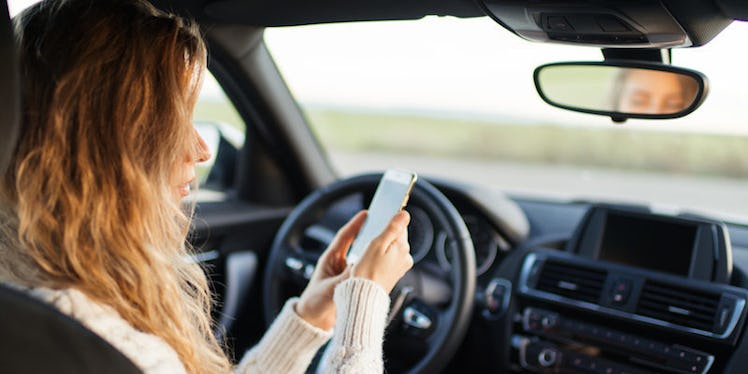
4 Facts That Prove Impaired Driving Doesn't Just Apply To Alcohol
The year 2015 came to an end.
Like every year before it, most of us celebrated.
We celebrated the accomplishments and milestones we achieved.
We celebrated the promise of what is yet to come.
With family and friends, we ate, rejoiced and ended the year in high spirits.
Traffic became more congested, and the weather created dangerous roads.
With the increase in impaired driving, the holiday season wasn't exactly the safest.
In an effort to keep the holiday season safe and positive, the POTUS designated an awareness campaign to prevent accidents and potential fatalities.
I’m not here to discourage you from enjoying the rest of 2016 or even to worry you, but I’d like to dismantle some common misinformation about impaired driving.
Here are four common misconceptions about driving under the influence:
1. Drunk Driving Versus Buzzed Driving
When we talk about driving under the influence, drunk driving is probably the first thing that comes to mind.
It is the most spoken about form of impairment, and it is the focus of our education when we speak about this topic.
Even so, it’s still a highly prevalent issue, with an average of 28 fatalities a day in the US.
During the Christmas and New Year period, the average number of fatalities involving an alcohol-impaired driver rose by 34 percent.
There are misconceptions over what exactly it means to “drunk drive.”
The national legal limit is having a blood alcohol concentration (BAC) of 0.08 percent, but most of us don’t carry breathalyzers around to track our intake.
Our BAC varies situationally, due to factors like body composition, age, amount of drinks and time since consumption, all of which affect that number.
It is common to hear your friends say they’re fine to drive because they only had a drink or two.
Even if you only feel “buzzed” and think you are okay to drive, it is still best to hand your keys to the designated driver.
It is difficult to determine how much is too much.
2. Smoking isn't less dangerous.
Smoking marijuana has become a part of the conversation about driving impairment.
When students are educated about the dangers of drinking and driving, it is likely they will also be told about the dangers of smoking and driving.
Even as the educational component of this issue has been given more attention, there has been a cultural misunderstanding of the differences between driving under the influence of alcohol and driving under the influence of marijuana.
One in five teens admit to driving while high.
Thirty-six percent said marijuana had little to no effect on their driving, and 34 percent said it made them better drivers.
What an individual may feel he or she is capable of can be incredibly different from reality.
Consuming marijuana in any form nearly doubles the risk of a collision, resulting in injury (or even death).
3. Prescription drugs count.
When we discuss driving under the influence of drugs, the focus is usually on marijuana.
This could be because of the expectancy to not meddle with anything else.
But what about good old prescription drugs?
We hardly ever talk about them.
In a 2010 nationwide study, out of the 46.5 percent of drivers who tested positive for drugs, 41.8 percent tested positive for a prescription drug (Xanax, Vicodin, OxyContin or Valium).
Varying drugs have varying effects on our bodies, and in different ways.
The lack of studies on prescription drugs and how they impair our abilities gives us a lack of information on what may be considered safe.
If you happen to be on a prescription that can alter your capabilities, slow your response time and cause you to be a hazard on the road, it’s best to not drive until you are taken off those pills.
Laws vary from state to state, so check your local laws and speak with your doctor.
4. Teens aren't the only ones who text and drive.
Campaigns against texting and driving have been growing in number and importance.
In these campaigns, we’ve developed an idea of just who these texting drivers are.
They’re young teens who are irresponsible and would rather text an “LOL” than keep their eyes on the road.
It is absolutely true that texting while driving is a problem with teens, as 13 percent of teenage drivers involved in car wrecks admitted to being on their phones at the time of the accidents.
In fact, 77 percent of young adults say they are confident they can safely text while driving.
I don’t know how confident you can be when you are 23 times more likely to be in an accident while texting.
In any situation, when you are not focused on the road and what is happening around you, you are putting yourself and others in danger.
This problem, however, is absolutely not limited to teens.
At least 27 percent of adults have sent or received text messages while driving.
So, while the face of the campaign may look young, this problem applies to everyone.
It has less to do with age and more to do with the influx of technology during every minute of our lives.
Keeping all of this information in mind, it is important to understand your limitations, even if you might not feel them.
Have a designated driver, take a cab or stay at a friend’s until you are sober.
Everyone should have a great 2016, but that would ensure we all make it through the year.
Stay safe.